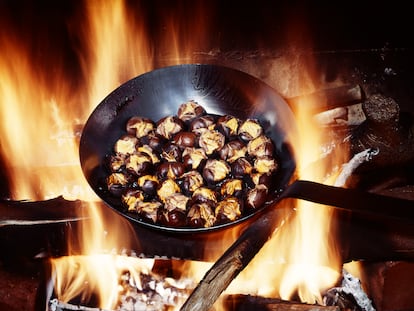Mory Sacko: Cuisine as a reflection of French society
The son of a Malian construction worker and a Senegalese domestic worker, the chef has become a national hero in France. Now, his new restaurant, Lafayette, is revolutionizing Parisian gastronomy

Mory Sacko poses in his new restaurant, Lafayette, located in the former palace of the Marquis de La Fayette, a French aristocrat, military officer and politician who was instrumental in the American and French revolutions. The Pompadour Room is decorated with a contemporary Hans Hartung piece and the work Dame de qualité from the Kraemer Gallery. A lamp designed by Lázaro Rosa-Violán is in the center.
In 2020, the name of a restaurant, Mosuke, began to circulate among Paris gourmets, along with that of its chef, Mory Sacko; word spread of his age, 27, and his origins, Senegal and Mali, which are infused in his dishes. Months later, Mosuke received a Michelin star. When it became impossible to dine there without making a reservation seven months in advance, Mory Sacko, now 31, became a regular on the France Info radio station and on the television program Cuisine Ouverte. His self-confidence, 6′2″ frame, ability to harmonize French-African and Japanese traditions, extraordinary friendliness and contagious smile came across over the airwaves and on the TV screen with such naturalness that he won over the whole city. In 2022 he opened Mosugo, a restaurant with a more affordable and spontaneous menu, the centerpiece of which was fried chicken in different versions, with nods to Africa and a genuine connection to young people, who have increased the chef’s visibility even more. Last September, Time magazine dedicated its cover to him, an honor that had been bestowed on only two French chefs until then: Michel Guérard, in 1974, and Alain Ducasse, in 2001.
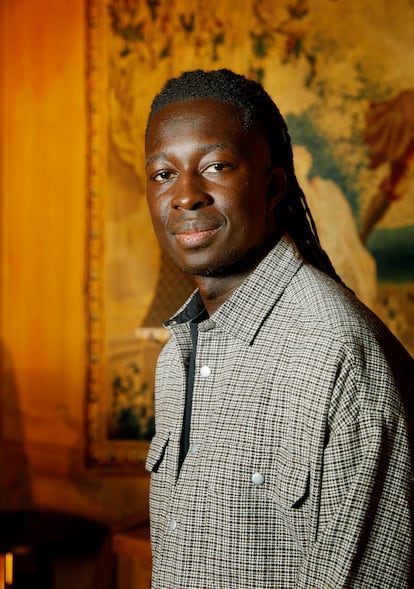
Considered a model of entrepreneurship, Sacko’s story is one of true creative ascent. Born in Champigny-sur-Marne, France, to a Malian father who worked in construction and a Senegalese mother who was a domestic worker, Sacko was the seventh of nine siblings. He grew up in the suburbs of Paris, and his interest in cooking stemmed from the boisterous dinners at which the family’s nine children gathered around their mother’s hot and spicy food. Those dishes, which have been passed down orally from generation to generation, form the basis of Sacko’s French cuisine with Japanese and Senegalese influences.
Now, at the height of his popularity, he is opening Lafayette, a restaurant located on Rue d’ Anjou, next to the Madeleine. The hotel entrepreneur Benjamin Patou (the ideologist and promoter) and the interior designer Lázaro Rosa-Violán have joined Sacko on this adventure. As if that were not enough, the restaurant is located in the hôtel particulier once inhabited by the Marquis de La Fayette, a French aristocrat, military man and politician who played a key role in the American and French revolutions. He fought in the American War of Independence with such determination that he became George Washington’s trusted general. His return to Paris coincided with the storming of the Bastille. He was too soft for the Jacobins and too revolutionary for the royalists. In 1790, the rebellious marquis helped to organize the July 14 feast in honor of the revolution, swore allegiance to the nation and wrote his friend with the famous line “I reign in Paris”; he was an exemplary Parisian who had returned to his palace to celebrate.
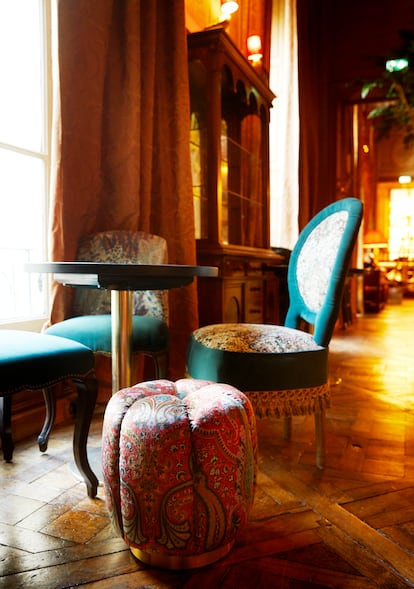
Lafayette the restaurant has just opened in that same mansion. Mory Sacko arrives looking like a symbol of today’s France. His body language, outfit and smile convey his undeniable optimism. A 300-year-old mansion and 100 diners a night await his creativity. Sacko received his training in haute cuisine from masters like Thierry Marx. He is the first chef of Senegalese descent to earn a Michelin star; those same roots heavily influence his cuisine. Responsibility, pride, pleasure are concepts present in his daily life: “Pride because it’s nice to celebrate my French identity alongside my African origins and my passion for Japan, which entered my life through manga characters and [whose cuisine] is absolutely the opposite of my mother’s cooking. Raw fish? cold rice? She says to me: ‘Can you eat that?’... at the same time, it is a responsibility because behind the cuisine, there is a cultural ambassador and that must be respected.”

Between triumphs and expectations, Sacko admits: “I never could have imagined this acclaim, I just wanted to open a restaurant and have fun. I’m not the typical chef who made cakes with his grandmother as a child; I don’t remember going into a kitchen until I was 15... and if I did, my mother would throw me out...” That’s one of the few routines that remains in Sacko’s life. With his ever-present smile, he admits that his mother still shoos him away: “She’s very classic, she doesn’t trust me, but they feel immense pride.”
Sacko has achieved so much in such a short time that one wonders if it was necessary to embark on such an ambitious project: “Yes, because I need to move away from what I know. Mosuke is introspective; with Lafayette, I can open myself to the outside. The emotion is conveyed differently: this is Parisian bistro inspiration and African inspiration. There are totems of African cuisine, like the braised rooster with mafé sauce and the fermented cassava soup with fish, as well as American inspiration in tribute to Lafayette, as reflected in the savory waffle with lobster.”
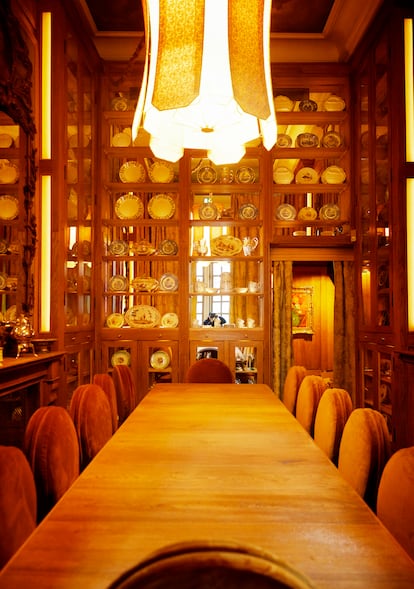
His vitality shaped in the past and his permanent curiosity about the future prompt Sacko to mention the importance of memory in cuisine. “I’m honoring a continent, but more specifically I’m honoring the memory of my mother, a woman who was born in the Ivory Coast, who left for Mali, who grew up in Senegal... it is her taste that I am after, and that is why I intend to share the emotion I have experienced in her dishes.”
Celebrated interior designer Lázaro Rosa-Violán is also seeking something among the tables, flowers and cables. He extends a greeting as he puts the finishing touches on the set-up with the help of his partner, fashion designer Mariano Moreno. Walking next to him, one sees mirrors that encourage mischief, embroidered fabrics, Angora wool, a clock from the La Fayette period, sanctum curtains, upholstery with French overtones and a warm, flamboyant atmosphere.
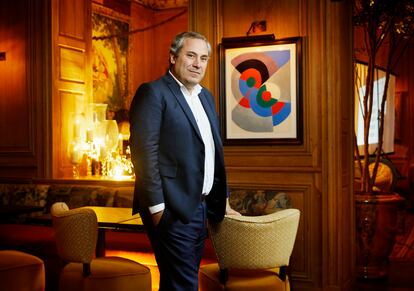
The natural treatment of things makes one feel like one has slipped into a scene by Fragonard. It can’t be easy to recreate such an exuberant world full of so much truth: “We had to connect these two worlds, that of Mory’s cuisine, which is so exotic, and that of overseas France and Lafayette,” the designer says. Rooms with names like Pompadour, Salle d’Armes and the pantry itself convey a romanticism peppered with contemporary touches. “I’m seeking to recreate a classic by experimenting with chromaticism. There are paintings from Benjamin Patou’s private collection alongside classic pieces from the Kraemer gallery.” Rosa-Violán has expertly created the macaron chair, the cannelé chair and the medallion chair. “The important thing is to create a unique experience. Exotic doesn’t have to be tropical. I didn’t want to be literal in recreating the 18th century, I wanted [to capture] the essence.” Both the lamps of his own design and the candles (each one in its own lantern) reveal the importance Lazaro attaches to lighting, and he repeats a phrase that seems to haunt him: “Yes, a well-lit garage is better than a palace with fluorescent lights.”
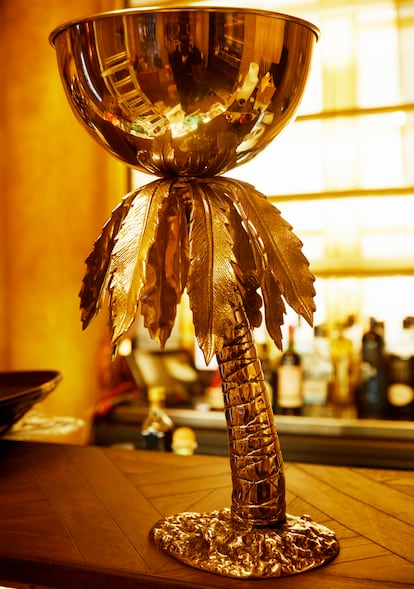
Illuminated by the spotlights and flashes from the photographs being taken of Mory Sacko, Benjamin Patou, 46, shows up, waving every now and then. When he understands that the hubbub is the result of the instructions that have been given to the waitstaff, he turns around and asks: “Guys, how does it feel to work in the best restaurant in the world?” Patou laughs in a very relaxed manner and does not hide his pride at coordinating this project. He is charismatic, and he knows it. With a keen sense of hospitality, he has built an empire of 40 restaurants at the forefront of festive dining in Paris, Saint-Tropez and Biarritz. The founder and CEO of the Moma group, Patou explains his role here: “My mission is to create human adventures and bring together talent. Lázaro and Mory are two juggernauts in this exceptional place.”
Patou asks how that photo shoot is going. “Ah, first one by one, then the three of us together, d’accord.” When the session begins, he adjusts his jacket and asks no one in particular: “Am I handsome?” A chorus of female voices responds in unison behind the camera, “Très beau.” Patou drinks sparkling water. When asked what is so special about this project, he says: “Oh, la, la, la... to start with, [its] location [is] unique in the world. To be able to go into the history of the building and its illustrious occupant and to understand what it represented, it was worldly and social, chez La Fayette was known all over France!”

Of meeting Sacko, he says: “I admire Mory, his cuisine, his identity and his values. When restoring this maison historique, I thought that a French chef like him, with his origins, would interpret the frontier concept of French cuisine better than anyone else and could represent Lafayette’s sojourns in the USA in his dishes, making this place different from everything else.”
According to Patou, what sets a restaurant apart is its ambition. “If I were a tourist I would be overpowered by this beauty. Here you get access to Mory’s brand at a good price. This is brasserie, this is cool, festive, cocktail, tac-tac, musique... La Fayette had vision and convictions, he was a defender of freedom. He is a symbol. And symbols are very important in life.”
Sign up for our weekly newsletter to get more English-language news coverage from EL PAÍS USA Edition
Tu suscripción se está usando en otro dispositivo
¿Quieres añadir otro usuario a tu suscripción?
Si continúas leyendo en este dispositivo, no se podrá leer en el otro.
FlechaTu suscripción se está usando en otro dispositivo y solo puedes acceder a EL PAÍS desde un dispositivo a la vez.
Si quieres compartir tu cuenta, cambia tu suscripción a la modalidad Premium, así podrás añadir otro usuario. Cada uno accederá con su propia cuenta de email, lo que os permitirá personalizar vuestra experiencia en EL PAÍS.
¿Tienes una suscripción de empresa? Accede aquí para contratar más cuentas.
En el caso de no saber quién está usando tu cuenta, te recomendamos cambiar tu contraseña aquí.
Si decides continuar compartiendo tu cuenta, este mensaje se mostrará en tu dispositivo y en el de la otra persona que está usando tu cuenta de forma indefinida, afectando a tu experiencia de lectura. Puedes consultar aquí los términos y condiciones de la suscripción digital.
More information
Archived In
Últimas noticias
Most viewed
- Alain Aspect, Nobel laureate in physics: ‘Einstein was so smart that he would have had to recognize quantum entanglement’
- The US bombing of Venezuela, in pictures
- Oil, gold and rare earth elements: the backdrop to US political tension with Venezuela
- Maps of the US attack on Venezuela: Targets, airspace and deployed fleet
- Delta Force, the elite US military unit that captured Maduro


